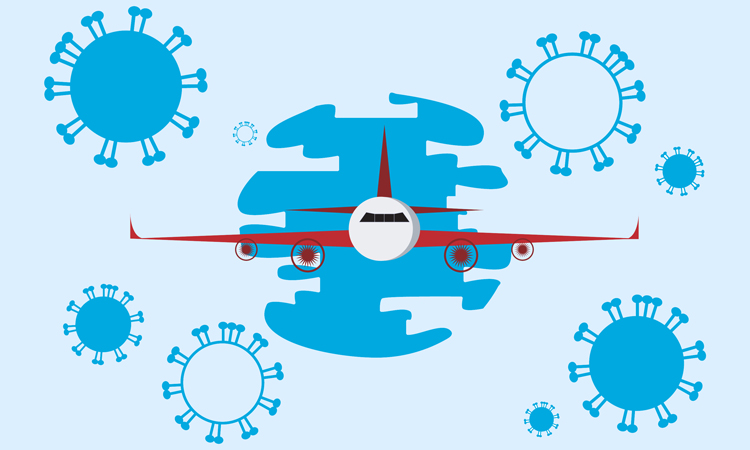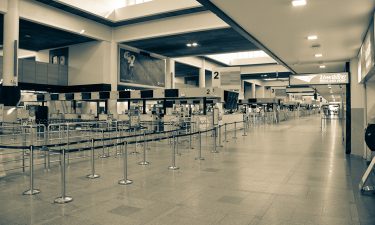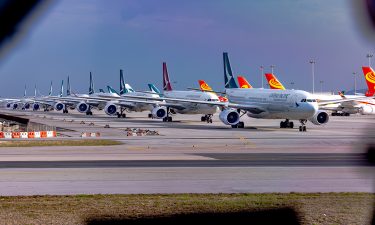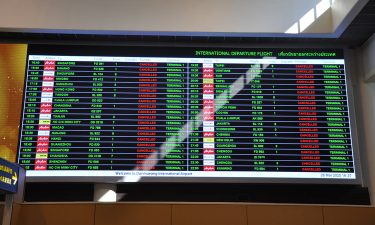Coronavirus roundtable: How is the aviation industry responding to the COVID-19 pandemic?
- Like
- Digg
- Del
- Tumblr
- VKontakte
- Buffer
- Love This
- Odnoklassniki
- Meneame
- Blogger
- Amazon
- Yahoo Mail
- Gmail
- AOL
- Newsvine
- HackerNews
- Evernote
- MySpace
- Mail.ru
- Viadeo
- Line
- Comments
- Yummly
- SMS
- Viber
- Telegram
- Subscribe
- Skype
- Facebook Messenger
- Kakao
- LiveJournal
- Yammer
- Edgar
- Fintel
- Mix
- Instapaper
- Copy Link
Posted: 15 April 2020 | Leah Hockley (International Airport Review) | 4 comments
As part of International Airport Review’s exclusive coronavirus roundtable, representatives from ACI Asia-Pacific, the Airport Operators Association, the Australian Airports Association and Tidal Basin discuss the impacts of COVID-19 on aviation, and what is being done by the sector in order to further prevent the spread of the virus.


Participants:
  |   |   |   |
Stefano Baronci Director General, Airports Council International (ACI) Asia-Pacific | Simon Bourke Chief Executive Officer, Australian Airports Association (AAA) | Karen Dee Chief Executive Officer, Airport Operators Association (AOA) | Stephanie Murphy Assistant Vice President of Preparedness, Resiliency and Emergency Management, Tidal Basin |
What impact, so far, has COVID-19 had on the aviation industry’s revenue intake? Will this trend continue in the following months?
Baronci: Asia-Pacific and Middle Eastern airport revenues are under tremendous pressure three months into 2020 amidst the impact of the COVID-19 outbreak. China and other Asian countries made significant efforts to contain the transmission of the virus however, as we know, it has spread to other regions of the world. We can expect the same pressure there and, by now, a global impact.
Unlike other players in the aviation industry, when traffic demand falls, airports have limited ways of reducing costs.
Airport revenue generation is directly linked to traffic levels. The flight bans and cancellations are leading to less flights, hence less aeronautical revenue coming in. Unlike other players in the aviation industry, when traffic demand falls, airports have limited ways of reducing costs. The cost of operating airport infrastructure remains the same, and airports can’t close down or relocate terminals and runways.
The other aspect to consider is non-aeronautical revenues, which are necessary, as aeronautical revenue alone cannot cover all airport operations and capital cost. For some hub airports in the region, non-aeronautical revenues are the principal revenue source. On average, Asia-Pacific airports derive as much as 45 per cent of their revenues from non-aeronautical sources. The drop in passengers has a significant impact on the airport’s and airport retailer’s bottom line.
On the human side, it also impacts the community and all of the personnel working with the various sectors and service providers at the airport. It has become common for retailers and airlines to ask their personnel to take unpaid leave during this troubling time.
Bourke: These events have impacted the aviation industry in a way that we simply haven’t seen before. The Australian Airports Association (AAA) estimated that, in March 2020, Australia’s major airports would lose more than $500 million in aeronautical revenue alone, compared to 2019. The true cost will depend on how long travel restrictions remain in place and how quickly the recovery comes. While airports are feeling the impact of falling demand and travel restrictions, we know there are many others in the community feeling this too. Every lost passenger is a loss not just to us, but to the retailers in our terminals, the taxi and ride-share drivers and the other airport businesses that rely on us and the passengers we serve. So, the focus now is on working together with airport partners to make sure we remain open for business and ready for recovery when the time comes.
On the other hand, how has passenger traffic been affected?
Baronci: Entering the new decade, some airports in the region were generating positive growth leading up to the Lunar New Year. Then, the severity of the virus became known.


At this juncture, it is important that the industry and regulators work together to decide on relief measures to address the current challenges and develop recovery plans for the entire aviation value chain. Airports Council International (ACI) believes that any measure should be evidence-based and should take a balanced approach, taking into consideration the need for people to continue necessary travel but does not oblige airlines to fly empty aircraft, which would be unwarranted and unsustainable.
For example, there have been recent calls for a global suspension of the 80 per cent slots usage requirement – commonly referred to as the 80/20 rule. This 80/20 rule allows a carrier to continue using the same slot in the next scheduling period, provided that it has used that allocated slot for at least 80 per cent in the previous period. This would be a disproportionate response in the absence of a global pandemic at the time of writing, and continued demand from many regions, including North America and much of Europe. We believe a blanket suspension of the 80/20 rule would hamper traffic recovery once the COVID-19 impact diminishes and the propensity to fly increases again.
Stay up to date with all the impacts, data and regulations on COVID-19 using our live 24-hour blog.
Bourke: We had already seen significant impacts on passenger numbers before wider travel restrictions were introduced in Australia in March 2020. In February 2020, Australia’s two largest airports saw declines in international passenger numbers of approximately 17 per cent compared to the same month in 2019. Those falls have, of course, increased, as travel restrictions have come into force and airlines have cut capacity. Australia’s two domestic airlines have been required to suspend international operations and significantly scale back domestic operations, so we are now seeing far more limited flight schedules nationally. However, there are still passengers that need to fly, and our airports are making sure essential travel continues during this time.
The impact so far has been dramatic, with a number of airports now having zero or near-zero passengers travelling through their terminals.
Dee: The impact so far has been dramatic, with a number of airports now having zero or near-zero passengers travelling through their terminals. At the same time, airports are working hard to remain open for critical services, such as repatriation flights and the increased number of full-freight flights, but also air ambulances, HM Coastguard, military flights, life-line services to remote communities, flying crew out to the oil and gas rigs in the North Sea and supporting maintenance of offshore wind.
This is a challenging time for airports: They are trying to continue to play their vital role for local communities whilst their main source of revenue disappears. It is very difficult to see how this will play out in the coming months, as we are unsure how long the COVID-19 pandemic will last, or indeed how quickly economies and societies rebound from their lockdowns. As a sector, we need to be ready for all eventualities – and that is why the Airport Operators Association (AOA) has been so vocal in calling for UK government support to see us through the worst of it and ensure airports stand ready to support the recovery, when it finally comes.
What actions have been put in place by the industry – both regional and global – to limit the virus spreading?
Baronci: Unfortunately, outbreaks of communicable diseases are not new to the aviation industry but, fortunately, airport members have learned from previous situations and, with the help of associations such as ACI, have prepared themselves.
ACI has documented a series of provisions in a number of areas to enhance preparedness in its Airport Preparedness Guidelines for Outbreaks of Communicable Diseases publication. These are related – but not limited to – elements like communication, inbound and outbound screening, emergency response and coordination with relevant authorities. Airports have also undertaken additional measures related to hygiene, work-from-home policies and health declarations.
Air travel is essential to global trade, and that’s why we must find ways to continue travel in the safest possible way. Coordination with other relevant organisations, such as International Civil Aviation Organization (ICAO) and the World Health Organization (WHO), is a must.
The first priority of all our members is the health and safety of their people and passengers.
Bourke: The first priority of all our members is the health and safety of their people and passengers. Australian airports are working very closely with the government to make sure that the latest health and safety advice is followed, and we are seeing strong coordination on the ground between airports, airlines and government. While that coordination is an important part of day-to-day airport operations, it has been absolutely essential when supporting the government’s new travel restrictions and screening measures.
Did you see International Airport Review’s exclusive industry briefing with Angela Gittens regarding how aviation should structure its plans for a post-COVID-19 world? Watch it on demand now to hear her advice and new statistics.
Dee: The aviation industry has had to cope with pandemics before, and we know the important role we play to prevent the spread of disease. In the UK, airports have closely followed the advice of the four national public health authorities for England, Wales, Scotland and Northern Ireland by putting in place screening where requested, but also widespread information campaigns on how travellers should respond to the virus. Airports have also worked closely with airlines, particularly where they had concerns over individual travellers prior to the virus spreading in UK communities. This is all coordinated at a European and global level, for example through the European Aviation Crisis Communication Cell. At times, the public health advice has not always been in line with what the public felt we should do, and that has been challenging for airports to manage. The line between what is the best advice from medical experts and the measures that the public wants to see for reassurance is one that needs to be finely balanced.
Murphy: The U.S. aviation industry is limiting interaction and practicing social distancing, as well as enhancing cleaning procedures within the guidelines provided by the Centers for Disease Control and Prevention (CDC).
How has the outbreak impacted airport operations?
Baronci: By now, we are all too familiar with the shocking images of empty airports! The outbreak has impacted airport operations in many ways.


To deal with preventive measures, airport staff are being redirected to handle things from temperature screenings and collecting health declaration, to adjusting the airport infrastructure, reserving specific parking gates for flights coming from severely-impacted countries and creating triage areas. To deal with the impact, airports are needing to find space on the tarmac for parked fleets.
As a highly-visible industry, aviation can sometimes be perceived as a high-risk industry. We need to better emphasise to the travelling public that the aviation industry takes the wellbeing of travellers, employees and all those that pass through an airport very seriously.
Bourke: This has been such a rapidly changing situation and has impacted all aspects of airport operations. Airports have implemented a range of new measures to support social distancing and are providing additional cleaning measures to ensure the health and safety of their workforce and passengers. In many cases, that is changing how airport staff work and interact. Airports have also been working very closely with their airline partners, retailers and suppliers as the industry has responded to falling demand. We all need to operate flexibly to work through this.
Dee: As I said earlier, with zero or close-to-zero passengers, airports across the UK have significantly downscaled their passenger operations. From closing sections of a terminal to closing whole terminals and even entire airports, sometimes only to passengers but also wholly closing down to all traffic. However, airports are mindful of the role they play for their communities, and a lot of that is not about passenger operations. The challenge has been to balance the need to keep the airport open with the financial reality of that.
Airports are impacted by staffing shortages, low passenger levels and attempts to keep staff who are deemed at a higher risk of infection safer through social distancing.
Murphy: Airports are impacted by staffing shortages, low passenger levels and attempts to keep staff who are deemed at a higher risk of infection safer through social distancing. These efforts include working from home and liberal leave. Airport managers are forecasting how their operations will be impacted if the workforce of critical or emergency personnel are exposed to or confirmed to have COVID-19. If this were to happen, there would not be enough personnel to staff important positions for Part 139 requirements, such as the Aircraft Rescue and Firefighting (ARFF) apparatus, air traffic control (ATC) tower or airport operations.
Do you think the aviation industry’s response was quick and efficient enough?
Baronci: Here, in the Asia-Pacific region, the memories of the SARS outbreak of 2003 are still very vivid. The information flow has been much quicker and more transparent than in the past, and this has favoured more effective planning. Airports in this region are familiar with the procedures. Coupled with guidance from health ministries and authorities, they acted timely and in a measured way without causing panic.
Bourke: Airports are dynamic businesses and have been able to work quickly to respond to COVID-19. It’s fair to say that we’re in unchartered territory and the pandemic is affecting airports on a scale not seen before. While the industry has deep expertise to draw from in a time like this, it has required all of us working in aviation to continue to adapt and learn as we go. We have seen airports and airlines move very quickly to adjust their operations, both in Australia and overseas. That’s been really important to make sure that the industry is in the best possible position to support a strong recovery in the future.
Dr. Karsten Benz, Professor for Aviation Management at Frankfurt University, explains that, in order to secure a successful future for as many airports as possible post COVID-19, flexible and immediate action is mandatory.
We could be at the start of a prolonged period of no to limited air traffic.
Dee: The impact of the virus has been a rapidly developing situation. Within a couple of weeks, in the UK, we went from no restrictions in public life to a nationwide lockdown – and airports have done their utmost to respond appropriately to each development. Whether, overall, we have taken the right approach – I think it’s too early to look at that in depth; we could be at the start of a prolonged period of no to limited air traffic. Much depends on how the UK government responds to that and how they will support airports and the wider economy through that. Once this is all over, I am sure we will look back and see what lessons we can learn.
Murphy: The U.S. aviation industry’s response was to follow guidelines provided by the CDC for cleaning impacted areas and minimising the spread of the virus through handwashing and other cleaning methods. Many airports also began, early on, to discuss business continuity plans. Assessing their critical functions and confirming who their emergency personnel were allowed them to quickly distance workers from each other through remote work. Some airports are also managing the response to the incident through Emergency Management departments and virtual Emergency Operations Centers (EOC). So, yes, the response was quick and efficient – it supported the national direction for social distancing, mitigated further spread, ensured the continued operation of airports and managed the incident.
What is being done in order to ensure the continuation of essential services?
Baronci: Airports, in cooperation with respective health ministries, are implementing preventive measures throughout terminals to deal with the outbreak – such as temperature checks, health screenings, installing extra hand-sanitising stations, stepping up scheduled cleaning and enhanced sanitisation efforts.
Some airports have taken to splitting some of their essential services or airport systems teams into two; one working onsite while the other supports remotely. This allows for rotation or fallback. In the event of any member of the onsite team getting infected or falling ill, the second team can step in to maintain business continuity.
Some airports have also implemented flexible office hours or meal breaks for other personnel, with the overriding consideration to ensure safety and security, which forms the basis of essential services.
In response to the drop in passenger traffic, other airport partners – such as retailers, food and beverage concessions, and airlines – while maintaining a certain level of necessary services, have taken to adjusting rosters and work schedules to minimise overcrowding of frontline personnel onsite. In some instances, frontline personnel are also asked to take unpaid leave.
Airports are doing everything they can to keep their airports open and make sure that they’re ready to support a strong recovery when the time is right.
Bourke: Airports are doing everything they can to keep their airports open and make sure that they’re ready to support a strong recovery when the time is right. It is really important to make sure that the people that continue to fly today feel safe and secure when they’re at the airport. It’s absolutely essential that supply chains remain open so that we can continue to meet the needs of the community. Airports are working very closely with government agencies to make sure that essential travel continues in line with health and safety requirements.
Dee: The fixed costs of an airport are about 70-80 per cent of their overall cost base, whether there is one flight or 100 operating. That means airports have had to make tough decisions on cancelling or postponing capital expenditure, furloughing non-essential staff, pay cuts and a range of other measures to limit expenditure to such levels that the airport can stay open for as a long as possible in order to continue serving our communities. At the time of doing this interview, we’re clear that time is running out and that the UK government needs to step in to support airports to remain open for the critical services their local communities rely on. The added complication is that staff who are furloughed may have regulatory requirements to stay current and able to return to their jobs once the pandemic has receded. An air traffic controller, for example, has to work a certain number of hours in their sector of airspace every month. If they don’t, their return to work could be delayed while they go through training and, thus, the operational recovery could be hampered. Airports are grappling with all these operational challenges currently.


Murphy: Airports have activated their business continuity plans, are running virtual Emergency Operations Centers (EOC), and identifying minimum staffing levels and shift work to ensure essential services continue for as long as possible. The challenge with this pandemic is that, although airports may proactively anticipate and act upon the events presented, the situation is changing so rapidly and can so suddenly affect the workforce that the airport may not have a choice to limit essential services. This incident is historic and unlike any other we’ve seen. Furthermore, catastrophic incidents that the U.S. has previously experienced has never affected the entire country at once. This now leaves many who have previously relied on mutual aid or partners for help to fend for themselves, as those partners are all-hands on deck with their own issues.
How do you believe aviation industry stakeholders should adapt to prevent a similar outbreak occurring in the future?
Baronci: The aviation industry, along with other transportation sectors, like maritime, rail and road, play a role in limiting the spread of communicable diseases. No doubt we will have learnings from this particular outbreak and new procedures will find their way into airport operational guidelines and industry best practices for the future.
Bourke: Whenever we are faced with such an unprecedented situation, there will inevitably be learnings we can take from it. It will be important that we all – not just those of us in aviation – make sure those lessons are integrated into our planning and operations in the future. This experience has shown that the industry must always be ready to respond to global shocks – whether that’s a pandemic or another major event – and that supporting our people and passengers must always come first. Airports are resilient businesses, and they need to be because they are essential infrastructure that drive our economy. Supporting the industry’s resilience beyond this most difficult time will be crucial.
To better prepare the workforce, business continuity or continuity of operations, plans should be developed, trained on and exercised.
Murphy: I don’t think we can. I think this is truly a case of consequence management. To better prepare the workforce, business continuity or continuity of operations, plans should be developed, trained on and exercised. Airports should also work through multiple courses of action or planning assumptions so as to have multiple options to choose from when confronted with the emergency. A long time ago, I learned from military colleagues to always have a PACE plan – primary, alternate, contingency and emergency plans – that can be utilised at a moment’s notice, because the entire team understands the course of action when presented with the scenario warranting one of the PACE options.
Biographies
Stefano Baronci began his role as Director General of Airports Council International (ACI) Asia-Pacific in December 2019, after being Director of Economics at ACI World for almost four years. Baronci has also previously held roles at the International Air Transport Association (IATA), Assaeroporti and ACI Europe.
Simon Bourke is the Acting CEO and Policy Director of the Australian Airports Association (AAA), the national industry body representing over 340 airports across the country. Bourke has been with the AAA for over six years and leads the association’s policy, advocacy and government relations agenda on a wide range of issues that are critical to the ongoing success of the industry.
Karen Dee joined the Airport Operators Association (AOA) as Chief Executive in 2017. Dee has more than 20 years’ experience in policy development, communications and representation activities within the transport sector. Her career has incorporated roles in government, consultancy and trade associations including: the Department for Transport, Market Access, the Road Haulage Association, CBI, Policy Solutions and more recently, the Freight Transport Association where she worked as Director of Policy for six years.
Stephanie Murphy, a Certified Emergency Manager, has over 18 years of experience in the areas of programme development and project management in the emergency management and transportation industries. As well as being Assistant Vice President of Preparedness, Resiliency and Emergency Management at Tidal Basin, she currently serves as co-Chair of the American Association of Airline Executives (AAAE) Emergency Management Working Group and as Vice-Chair of the Transportation Ad-Hoc Committee of the International Association of Emergency Managers (IAEM).
Related topics
Aeronautical revenue, Airport crisis management, Augmented reality (AR)/ Virtual reality (VR), COVID-19, Economy, Passenger experience and seamless travel, Passenger volumes, Safety, Terminal operations
Related organisations
Airport Operators Association (AOA), Airports Council International (ACI World), Airports Council International Asia-Pacific and Middle East (ACI APAC & ME), Centers for Disease Control and Prevention (CDC), China Ministry of Transportation, International Civil Aviation Organization (ICAO), The Australian Airports Association (AAA), Tidal Basin, World Health Organization (WHO)
Related regions
Asia Pacific and Oceania, Central and South America, North America, United Kingdom and Ireland



















I honestly think that air travel is the safest way to travel during the COVID crisis when compared with the other means although you have to be more cautious and take all the safety measures that we can to protect ourself and our loved ones from this deadly virus. Washing hands regularly, practicing good hygiene, covering up, Mianinting social distance are few important factors that one should practice while traveling. Airports now are majorly responsible as they need to check all the safety measures so that every passenger is safe. The best way to make sure that everything checks out is passenger feedback. the airports now should leverage this unstructured data and know the region where they are lacking behind.
Thank you so much for sharing this informative article about the aviation industry. This website is very useful for us and for students.
thank you for sharing this amazing post
Thank you for sharing this information with us, through this article I know much more about the aviation industry. You guys are doing a marvelous work. Waiting for your Next article like this.